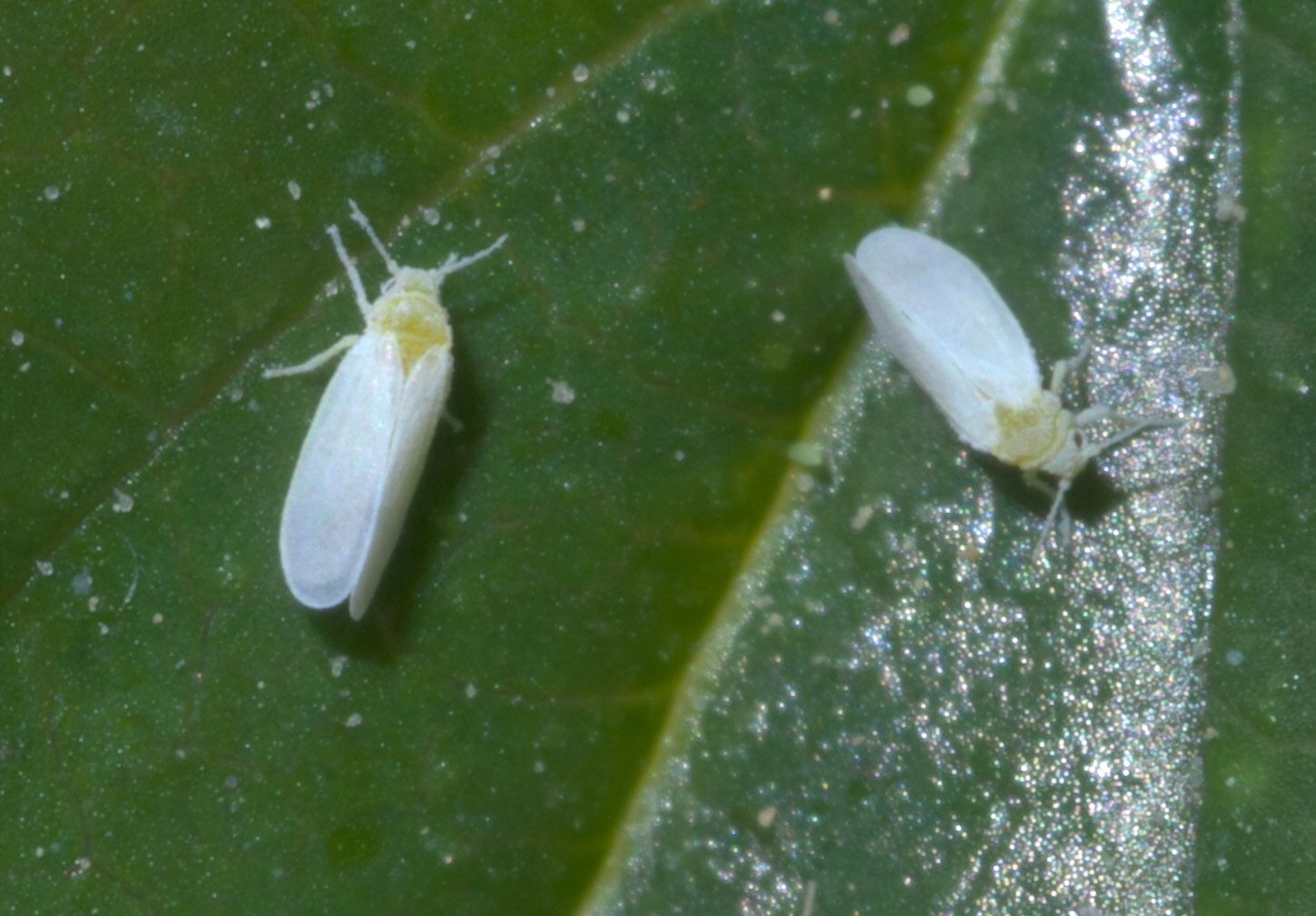Whiteflies
Whiteflies are soft-bodied, winged insects that threaten various plants, including tomatoes, sweet potatoes, and cabbage.

Proper identification is crucial to apply the appropriate treatments and preventions, ensuring the health of your plants.
These pests are closely related to aphids and mealybugs and can be identified by their tiny, white, fly-like appearance.
Understanding the life cycle of whiteflies can help combat their infestations.
Various methods are available for their control, such as biological control, organic pesticides, and chemical pesticide control.
Evaluating your specific situation and choosing the proper treatment will help you gain control over these pests and protect your plants effectively.
Identifying Whiteflies
Differentiating Adult Whiteflies
Adult whiteflies are small, winged insects, typically white or light yellow.
They resemble tiny moths with delicate triangular wings and are about the size of a grain of rice.
One common species is the Trialeurodes vaporariorum, or greenhouse whitefly.
You can usually find them on the undersides of leaves, where they feed on plant juices and leave behind a sticky residue.

Recognizing Nymphs
Whitefly nymphs are even smaller than the adults and could be mistaken for eggs or specks of dust. They are oval, flat, and translucent, often pale yellow.
They'll molt a few times as they grow before developing into adults.
To identify nymphs, check the underside of leaves, where you've spotted adult whiteflies since they tend to lay eggs close to their feeding sites.
Whitefly Life Cycle
The life cycle of whiteflies begins with eggs, typically laid by adult females on the undersides of leaves.
These eggs hatch into nymphs, which are small, flat, and oval-shaped.
The nymphs feed on plant sap, going through multiple growth stages called instars before reaching the pupae stage.
Whiteflies undergo a significant transformation during the pupal stage, developing wings and becoming adult insects.
They feed, reproduce, and lay new eggs as adults, starting the life cycle anew.
Depending on the conditions, whiteflies can develop several generations throughout the growing season, causing continuous damage to your plants if not properly controlled.
Symptoms of Whitefly Infestation
Physical Damage to Plants
Damage can occur in various ways when your plants are infested with whiteflies.
Whiteflies feed on the sap of a plant, resulting in yellowing leaves and reduced plant vigor.
The feeding process also causes the plant to exude a sticky honeydew substance, which can lead to the growth of sooty mold on the leaves, further weakening the plant and reducing its ability to photosynthesize.
Visible Signs of Infestation
As you examine your plants, there are a few visible signs of whitefly infestation you should look for.
One is the presence of tiny, white, moth-like insects on the leaves, especially on the undersides.
Another sign is the appearance of yellow spots or patches on the leaves, which indicates whitefly feeding.
You may also observe a sudden, cloud-like swarm of whiteflies emerging when you disturb an infested plant. This can indicate that your plants are dealing with a whitefly infestation.
Natural and Chemical Treatments
Natural Treatment Methods
One effective natural treatment for whiteflies is using predators such as ladybugs, spiders, green lacewing larvae, dragonflies, and hummingbirds.
These predators help keep the whitefly population under control without using chemicals.
Another natural method is spraying infected plants with water, as a strong spray can dislodge whitefly adults, larvae, and eggs.
Chemical Treatment Options
Consider using chemical treatments like neem oil, insecticidal soap, or horticultural oil for more persistent infestations.
Neem oil disrupts the insects' hormone system, making it difficult for them to grow and lay eggs.
Insecticidal soap and horticultural oil work by smothering whiteflies, disrupting their cell membranes, and causing them to dehydrate.
When using chemical treatments, follow the manufacturer's instructions and monitor the potential impact on beneficial insects.
Effective Preventive Measures
Preventing Infestation in Greenhouses
Inspect your greenhouse regularly for any signs of whitefly infestation. Keep new plants in quarantine before introducing them to the main area, reducing the risk of introducing pests.
Use of Sticky Traps
Place yellow sticky traps near your plants to monitor and capture adult whiteflies. Replace the traps regularly to maintain their effectiveness and track the population changes.
Sanitation and Planting Practices
Maintain good sanitation by removing dead leaves and debris from your garden. Practice crop rotation with different types of plants, such as squash, to disrupt whiteflies' life cycles and prevent infestations from becoming established.
Frequently Asked Questions
How do you identify whiteflies?
Whiteflies are tiny, white, soft-bodied insects that can be found on the underside of plant leaves. They resemble miniature flies and are related to aphids and mealybugs.
What causes whitefly infestations?
Several factors, including excessive moisture, poor air circulation, and other pests, can cause whitefly infestations. They tend to be more prevalent in warm, humid environments.
What are effective treatments for whiteflies?
To treat whitefly infestations, you can use insecticidal soaps, horticultural oils like neem oil, or biological controls such as releasing natural predators like ladybugs or lacewings. Yellow sticky traps can also help in controlling their population.
How to prevent whitefly infestations?
Preventing whitefly infestations involves regular inspection of your plants for early infestation signs, improving air circulation, reducing excessive moisture, and using reflective mulches to help repel them. Introducing beneficial insects can also aid in preventing infestations.
Are whiteflies harmful to plants and humans?
Whiteflies can harm plants as they suck sap from the leaves, causing yellowing and curling, and also transmit plant viruses. However, they do not directly threaten humans, as they do not bite, sting, or transmit diseases.
Does neem oil help in controlling whiteflies?
Yes, neem oil can be effective in controlling whiteflies. It targets all life stages of the pests and helps prevent the growth of black sooty mold associated with whitefly infestations.


